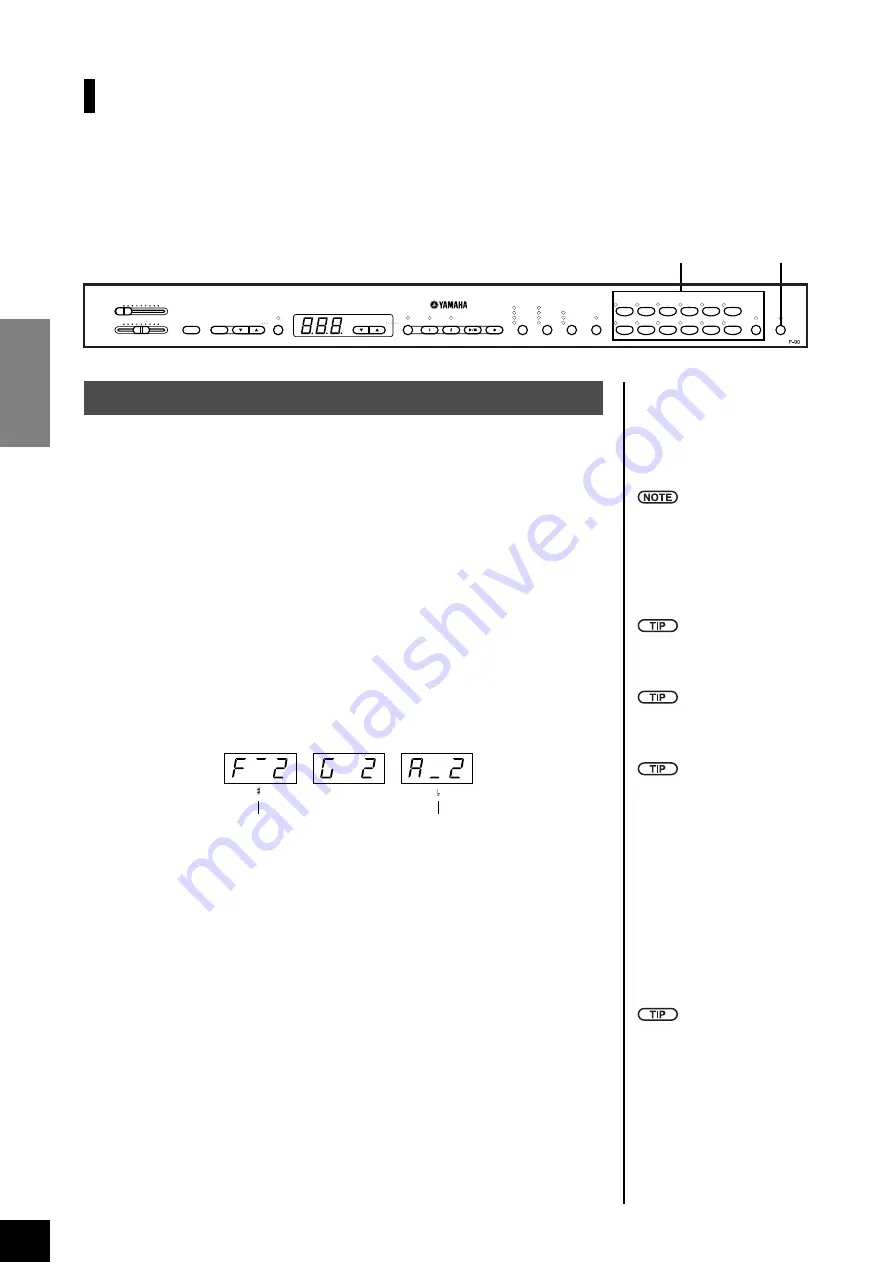
P-90
Selecting & Playing Voices
ENGLISH
24
Splitting the Keyboard Range and Playing Two Dif-
ferent Voices (Split mode)
Split mode enables you to play two different voices on the keyboard — one with the left hand and
another with the right hand. For example, you can play a bass part using the Wood Bass or Electric
Bass voice with the left hand, and a melody with the right hand.
1.
Engage Split mode.
Press the
[SPLIT]
button so that its indicator lights. The default setting
(WOOD
BASE)
will be selected for the left-hand voice at first.
The Function mode provides access to a number of other Split mode functions
(page 38). (If you make no settings for Split mode functions, the appropriate
setting will be set in each voice by default.)
2.
Specify the split point (the border between the
right-and left-hand range).
You can change the split point to any other key by pressing the key while hold-
ing the
[SPLIT]
button (the name of the current split-point key appears on the
LED display while the
[SPLIT]
button is held).
The split point is initially set at the F
2 key by default.
If you do not need to change the split point, skip this procedure.
3.
Select a voice for the right hand.
Press a voice button.
4.
Select a voice for the left hand.
Press the corresponding voice button while holding the
[SPLIT]
button. (The
indicator of the Left Voice button will light while the
[SPLIT]
button is pressed.)
To turn the variation on or off for the split voice, hold the
[SPLIT]
button and
press the
[VARIATION]
button or the currently-selected voice button.
[VOICE]
[SPLIT]
MASTER VOLUME
MIN
MAX
BRILLIANCE
MELLOW
BRIGHT
DEMO
START/
STOP
TEMPO/
FUNCTION#
PRESET
TRACK
GRAND
PIANO 1
GRAND
PIANO 2
VIBES/
GUITAR
CLAVI./
HARPSI.
E. PIANO
2
E. PIANO
1
CHURCH
ORGAN
STRINGS
CHOIR
E.BASS
JAZZ
ORGAN
WOOD
BASS
ELECTRONIC PIANO
VARIATION
SPLIT
VOICE
TRANSPOSE
REVERB
METRONOME
TEMPO/ OTHER VALUE
SONG
EFFECT
TOUCH
ON
ROOM
HALL 1
HALL 2
STAGE
PHASER
CHORUS
TREMOLO
DELAY
HARD
MEDIUM
SOFT
FUNCTION
– / NO
+ / YES
REC
START/
STOP
Procedure
Dual (page 23) and Split
(page 23) modes cannot be
engaged simultaneously.
A specified “split point” key is
included in the left-hand range.
The split point can also be set
via Function 4 (page 38).
[VARIATION] in Split Mode
You can turn the variation on or
off for Split mode voices. Nor-
mally, the voice indicator of the
right voice lights in Split mode.
The [VARIATION] can be used
to turn the variation for the right
voice on or off as required.
While the [SPLIT] button is
held, however, the voice indica-
tor of the left voice lights. In this
state the [VARIATION] button
turns the variation for the left
voice on or off.
[REVERB] in Split Mode
The reverb type assigned to the
right voice will take priority over
the other. (If the reverb is set to
OFF, the left voice’s reverb type
will be in effect.) Reverb depth
setting via the panel controls
(i.e. pressing the [–/NO] or [+/
YES] buttons while holding the
[REVERB] button — see
page 20) will be applied to the
right voice only.
An example of split-point key display
(F 2)
followed by a high bar if sharp
(G2)
(A 2)
followed by a low bar if flat






























